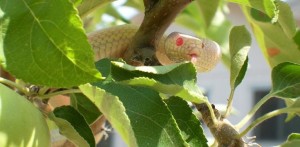It sounded like air escaping, but it wasn’t until it was too late that a Cordova woman realized what was actually making the noise.
Pam Cutter says she was bitten by a snake Tuesday afternoon that had been hiding behind her car tire.
“I was checking the air in my tire while it was on the car,” Cutter said. “I heard the hiss after I finished and I thought it was a leak.
“I put my hand behind the tire to check for the leak, and that’s when he bit me.”
The snake bit her about two inches above her wrist. Cutter never found out what kind of snake bit her because she “freaked out.”
“Everything I did was wrong. I panicked and ran over to my neighbor’s house,” Cutter said. “They tied off my arm and I was taken to the hospital by ambulance.”
At the Regional Medical Center, “They told me it appeared no venom had been injected.”
Derral Linder of Linder’s Snake Rescue and Removal in North says non-venomous bites from poisonous snakes, while not common, are far from rare.
“Snakes have knowledge that their venom is used to kill prey, and they know we are too big to be prey,” Linder said. “They can control not only whether they will inject venom but how much.
“The Centers for Disease Control says that 30 percent of all snake bites each year in the U.S. are dry. There are about 8,000 venomous snake bites. Of those, 8 to 10 are fatal.”
RMC emergency medicine physician Dr. Simons Hane says the cold-blooded reptiles are beginning to appear as the weather grows warmer.
“We don’t see a lot of snake bites here, usually about 10 to 15 each year,” Hane said. “The degree of a snake bite is determined by the level of pain and how quickly swelling spreads from the site of the bite.
“I was bitten about 15 to 18 years ago by a water moccasin and the pain was immediate. The bite felt like someone was pouring molten lead into the wound.”
Hane says there are commonsense precautions one should take in the event of a snake bite.
“We tell people they should never attempt to suck out the venom, cut the wound area or ice it under any circumstances,” Hane said. “Stay calm, elevate the area of the wound and get to a hospital as soon as possible.
“They are starting to come out and they are nothing to mess around with.”
Cutter says she will be more careful in the future. She’s also learned a very important lesson: “Not to stick my hand anywhere I can’t see it.”










